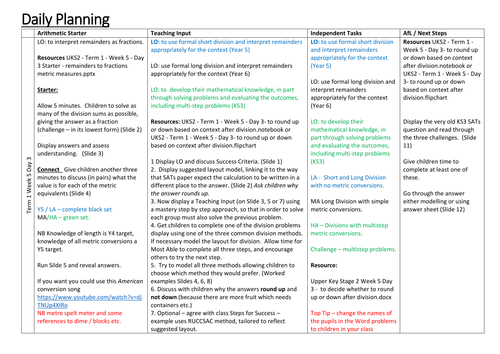





Starter:
- To interpret remainders as fractions
- To revise common metric conversions
Main Lesson:
- To use formal short division and interpret remainders appropriately for the context (Year 5)
- To use formal long division and interpret remainders appropriately for the context (Year 6)
- To develop their mathematical knowledge, in part through solving problems and evaluating the outcomes, including multi-step problems (KS3)
This lesson consists of:
A Starter consisting of a series of progressively harder division problems giving remainders to convert to fractions and their answers. A connect activity getting children to revise the metric conversions they will need in the independent task.
An Interactive Whiteboard teaching introduction for both Notebook and ActivInspire, to teach how to lay-out short and long division when answering word problems and to test the children’s ability to understand how context determine whether to round an answer up or down.
A 4 way differentiated series of calculations (including a Challenge Activity) where children are expected to solve a series of short and long division Word problems and round the answer according to context. More Able children will have to complete multistep problems. Answers are supplied to ease marking.
An AFL / Next Steps task based on previous a SATs question, to allow to introduce the fact that most problems aren’t simply one operation but usually are a combination of different operations.
Get this resource as part of a bundle and save up to 82%
A bundle is a package of resources grouped together to teach a particular topic, or a series of lessons, in one place.
UKS2 (Year 5 and Year 6) - complete set of Maths lessons for October
15 sets of complete lessons (3 x 5 days) covering current National Curriculum expectations for teaching short and long division, multiples, common multiples, prime factors, common prime factors, BODMAS, multiplication and division by powers of 10, metric measures, conversions between metric and imperial measures, and multi-step Word Problems. Each week ends with either an investigation of Word Problems linked to the topic studied. Every lesson includes: \- a Starter based on Arithmetic and / or previous learning and a Connect Activity designed to activate the children's interest in the topic being covered that day. \- two interactive teaching presentations designed to run on either Smartboard's Interactive Whiteboard or Promethean ActivInspire software. \- a detailed 4 way differentiated lesson plan including all relevant learning objectives and AfL / next step opportunities. \- a 4 way differentiated worksheet designed to cater for the learning of virtually all children in Year 5 or Year 6 regardless of ability.
UKS2 (Y5 and Y6) Division with remainders; fractions; estimation and checking calculations - 5 lessons
A set of 5 days' lessons covering: \- short and long division \- finding fractions from remainders \- rounding up or down after division in Word problems depending on context. \- the use of estimation / rounding, inverse operations / informal methods to check answers. Revision of: -Metric conversions -Rounding to nearest 1, 10, 100, 1000, 1000 -Quick mental arithmetic using all four operations.
UKS2 (Y5 and Y6) Term 1 Week 05 Division with remainders; fractions; estimation and checking calculations - 5 day lesson set
A set of 5 day's lessons covering: \- short and long division \- finding fractions from remainders \- rounding up or down after division in Word problems depending on context. \- the use of estimation / rounding, inverse operations / informal methods to check answers. Revision of: -Metric conversions -Rounding to nearest 1, 10, 100, 1000, 1000 -Quick mental arithmetic using all four operations.
Something went wrong, please try again later.
This resource hasn't been reviewed yet
To ensure quality for our reviews, only customers who have purchased this resource can review it
Report this resourceto let us know if it violates our terms and conditions.
Our customer service team will review your report and will be in touch.